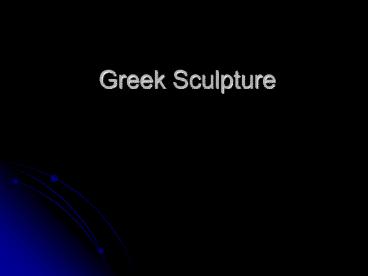Greek Sculpture - PowerPoint PPT Presentation
1 / 46
Title:
Greek Sculpture
Description:
Greek Sculpture Greek Sculpture Two Enduring Understandings about Greek sculpture: Greek sculpture demonstrates a discernable pattern of development that we can ... – PowerPoint PPT presentation
Number of Views:1305
Avg rating:3.0/5.0
Title: Greek Sculpture
1
Greek Sculpture
2
Greek Sculpture
- Two Enduring Understandings about Greek
sculpture - Greek sculpture demonstrates a discernable
pattern of development that we can categorize - A specific vocabulary can be used to describe
Greek sculpture
3
Objectives
- Identify periods of Greek sculptural development.
- Define vocabulary to describe sculpture.
- Apply period names and vocabulary terms to
analysis of example sculptures.
4
A Pattern of Development
- Enduring Understandings about Greek sculpture
- 1. Greek sculpture demonstrates a discernable
pattern of development that we can categorize
5
A Pattern of Development
Evolution of the Kouroi to the Kritios Boy and
Comparison with the Hellenistic Apollo
Belvedere. The Evolution of Realism 1) c. 600
BC, 2) c. 575-550 BC, 3) c. 560 BC, 4) c. 530-520
BC , 5) c. 515-500 BC, 6) c. 485 BC, 7) c. 320 BC
http//www.mlahanas.de/Greeks/Arts/Evolution.htm
6
A Pattern of Development
7
Greek Sculpture Development
- Periods and their Styles
- Vocabulary to Describe Styles
- Example Pieces
- Example Types
8
Periodization
- Historians use a technique we may term
periodization to assign events, individuals and
works of art and literature to a specific time
period.
9
Periods of Greek Sculpture
- Archaic
- Classical
- Hellenistic
500s and earlier B.C. 400s B.C 300s B.C. and
later
10
Archaic
11
Two Archaic Sculpture Types Kouros Kore
- Male kouros (youth) Female kore (maiden)
12
Classical
13
Hellenistic
Period ________
14
Vocabulary to Describe Greek Sculpture
- stylized elimination or exaggeration of details
subjects are portrayed using a pattern or
standard of expression - symbolic use of symbols to convey meaning
- idealize attempt to create perfect
representations - contraposotto weight shift that renders a
graceful attitude to the sculpture. - naturalistic or realistic portraiture, replicate
life without relying on ideals, styles, or
symbols we may think of this as life-like
15
How to look at Greek Sculpture
- Ask Three Questions
- To Identify the
- Period
- of a Greek Sculpture
16
How to look at Greek Sculpture
- What is the FACIAL EXPRESSION?
- What is the POSE?
- How are the KNEES portrayed?
17
How to look at Greek Sculpture
- What is the FACIAL EXPRESSION?
stylized elimination or exaggeration of details
subjects are portrayed using a pattern or
standard of expression note hair, eyes, nose,
mouth and symmetry
Archaic
18
How to look at Greek Sculpture
- What is the FACIAL EXPRESSION?
Classical
- idealized
- represents an attempt to create perfect
representation of the human form
19
How to look at Greek Sculpture
- What is the FACIAL EXPRESSION?
- naturalistic or realistic
- portraiture, replicates life without relying on
ideals, styles, or symbols - We may think of these pieces as life-like.
Hellenistic
20
Archaic
What is the POSE?
- note head position and attention
- note arm position and flexion
- note foot/leg position stylized/ or symbolic of
motion or being at rest the meaning is debated - note symmetry
21
Classical
What is the POSE?
- frozen action or static pose
- contraposotto
- weight shift that renders a graceful attitude to
the sculpture.
22
Hellenistic
What is the POSE?
- awkward position
- frozen moment
- emotion demonstrated
- physical age imperfection evident or exaggerated
Period ________
23
Archaic
How are the KNEES portrayed?
- block-like
- stiff, flexed muscles
- patella (knee cap) over emphasized
24
Classical
How are the KNEES portrayed?
- a pose in motion may render differences between
the two knees - muscles are more gracefully joined, often
somewhat over emphasized - patella (knee cap) slightly over-emphasized
25
Hellenistic
How are the KNEES portrayed?
- more graceful musculature
- knee cap evident but not over emphasized
- possibly obscured by clothing
Period ________
26
(No Transcript)
27
Hellenistic
How are the KNEES portrayed?
- more graceful musculature
- knee cap evident but not over emphasized
- possibly obscured by clothing
Period ________
28
Greek SculptureQuiz
29
The Laocöon Group (Rome, Vatican Museums)
30
Discobolos (c450 BC) Roman marble copy after
bronze original (Rome, National Museum)
31
Doryphoros Polykleitos (The Canon, or Spear
Carrier) marble, c450 BC (Vatican Museums)
32
Diadoumenos, or the Fillet Binder
Polykleitos (Roman copy after bronze original
c.450)
33
Wounded Amazon, copy after originals known to
have been created by Phidias for competition
Metropolitan Museum, New York
34
Wounded Amazon, copy after originals known to
have been created by Polykleitos for competition
?In Ephesus? Won by Polykleitos Vatican Museum
35
Greek Sculpture Quiz
Peplos Kore (c530 BC) polychromed (painted)
marble
36
Peplos Kore (c530 BC) polychromed (painted)
marble
37
Greek Sculpture Quiz
Moscophoros, the Calf-Bearer (Acropolis Museum)
38
Greek Sculpture Quiz
"Rampin Horseman" Athens, Acropolis Museum
39
Greek Sculpture Quiz
Kroisos from Anavyssos, grave marker (c540-515
BC) (Athens, National Museum) polychromed
(painted) marble
40
Greek Sculpture Quiz
Kroisos from Anavyssos, grave marker (c540-515
BC) (Athens, National Museum) polychromed
(painted) marble
41
Kritios (c480 BC) marble (Athens, Acropolis
Museum)
42
Aphrodite of Melos, second century BC (Paris,
Louvre)
43
Aphrodite of Melos, second century BC (Paris,
Louvre)
44
Greek Sculpture Quiz
Apollonios, Seated Boxer (Rome, Museo delle
Terme) )
45
Greek Sculpture Quiz
Satyr with Infant Dionysos (Rome, Vatican
Museums)
46
Greek Sculpture Quiz
Name_______________________ Date__________D
irections Examine the figures as noted. Above
and beside each figure create a flower as
indicated by the diagram on the balckboard.































